Leszno
6.43

Overview
Leszno is a village in Poland located in the Masovian Voivodeship, near the border of the Kampinos National Park. Despite its small size, the village boasts a rich history dating back to at least the 15th century, with the first written mention in 1423. In the 16th century, Leszno became a site of noble estates, and in the 18th century, the Baroque palace of the Łuszczewski family was built, surrounded by a landscaped park. In 1898, the Neo-Gothic Church of the Nativity of St. John the Baptist was constructed, featuring Art Nouveau polychrome interiors. The village witnessed numerous historical events, including the destruction of World War II, when approximately 75% of its buildings were burned down. Leszno was home to a sugar industry, and the "Michałów" sugar refinery played a significant role in the local economy until its closure in 2004. An interesting fact is that Robert Lewandowski, the renowned Polish footballer, began his soccer career in Leszno. The village is also home to various religious communities, including the Roman Catholic Church and the Mariavites. Leszno is a place of architectural, cultural, and historical diversity, offering both heritage sites and activities related to industry and social life.
Location
City
Blonie Deanery
Tertiary Administrative Division
Leszno
County
Warsaw West County
State
Masovian Voivodeship
Country
2025 Wizytor | All Rights Reserved